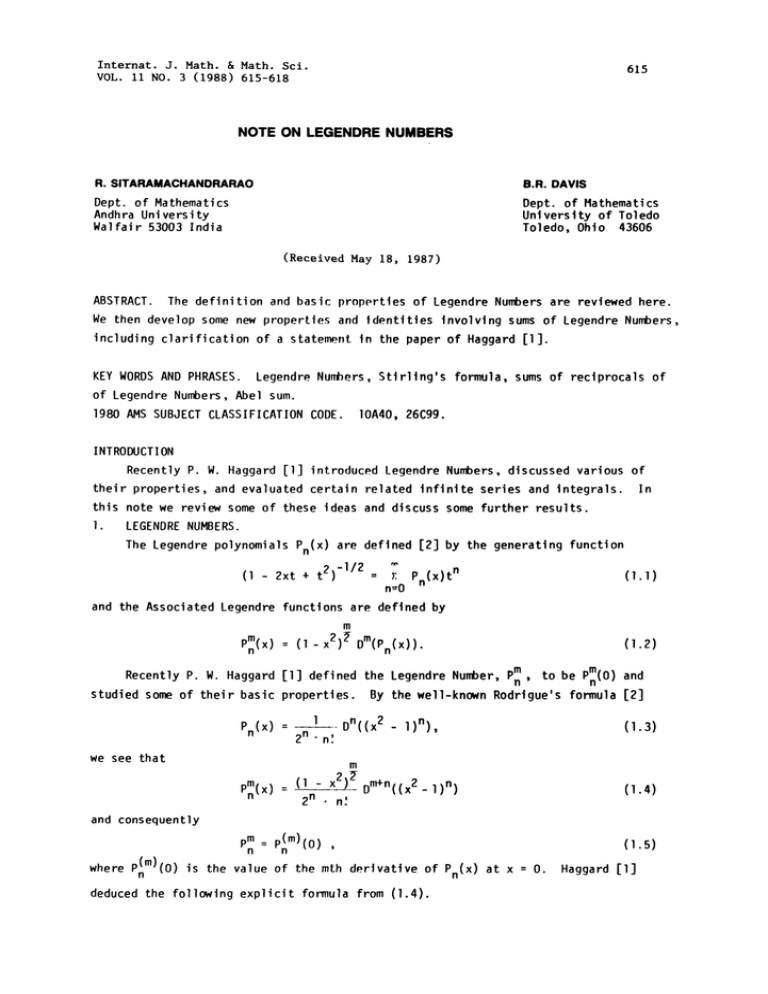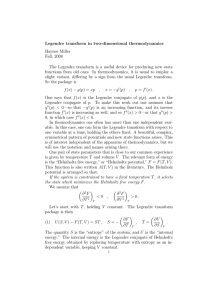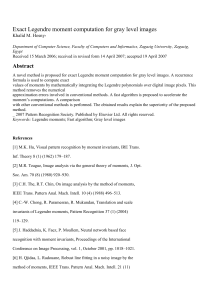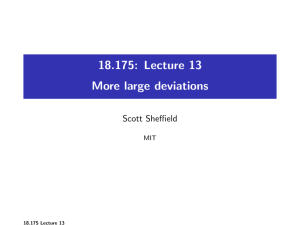Document 10437654
advertisement

Internat. J. Math. & Math. Sci.
VOL. Ii NO. 3 (1988) 615-618
615
NOTE ON LEGENDRE NUMBERS
R. SITARAMACHANORARAO
Dept. of Mathematics
Dept. of Ma thema t cs
Andh ra Uni ve rs ty
Walfair 53003 India
University of Toledo
Toledo, Ohlo 43606
B.R. DAVIS
(Received May 18, 1987)
ABSTRACT. The definition and basic properties of Legendre Numbers are reviewed here.
We then develop some new properties and identities involving sums of Legendre Numbers,
including clarification of a statement in the paper of Haggard [I].
KEY WORDS AND PHRASES. Legendre Numbers, Stirllng’s formula, sums of reciprocals of
of Legendre Numbers, Abel sum.
1980 AMS SUBJECT CLASSIFICATION CODE.
IOA40, 26C9g.
NTRODUCT ON
Recently P. W. Haggard [I] introduced Legendre Numbers, discussed various of
their properties, and evaluated certain related infinite series and integrals. In
this note we review some of these ideas and discuss some further results.
I.
LEGENDRE NUMBERS.
The Legendre polynomials
(l
Pn(X)
2xt + t
[2] by the generating function
are defined
2)-1/2
}-:
Pn(X) tn
n--O
and the Associated Legendre functions are defined by
m
pm(x)
n
(l-x2) Dm(p n (x))
(l 2)
Pmn,
P(O)
Recently P. W. Haggard [1] defined the Legendre Number,
and
to be
studied some of their basic properties. By the well-known Rodrigue’s formula [2]
Pn(X)
2 n "n
Dn((x 2- 1)n),
we see that
(].3)
m
P(x)
(l
pm=
pm) (0)
2n
x2) Dm+n
n
(x 2 ]) n
(1.4)
and consequently
n(m)(O)
where v
is the value of the ruth derivative of
deduced the following explicit formula from (1.4).
(.s)
Pn(X)
at x
O.
Haggard [1]
616
R. SITARAMACHANDRARAO and B.R. DAVIS
m + n odd
m > n and
0
pmn
0
n-m
(-1) 2 (n+m)
m+n even,
He also gave a table of pmn for 0 m n 8
We note that (1.6) follows dlrectly from (1.1).
Bi nomi a
n=O
m
<
n.
In fact by (1.1) and the
theorem
Pn(x)t n
,
t(2x-t)} -I/2
{I
n=
1"3’5.’.(2n- !) tn(2x_ t) n
n
2
n’.
- E2n)’2(n’.) k- Of: (-1)kc)(2x)n-k tn+k
+
n=l 2
+
,
(-l)_m-n__(Zn)
tm
_m<n<m
2
m=1
x2n-m
mn
2
so that
Pn(X)
2 -n
n/2
(-I)i
i=O
Cn;ll ;2(n_l)
xn-2i
\n-|
Writing m for n-2i in this, we get
Pn(X)
2 -n
n
n + m)/
n m)/
(-I) 2
m=O
_
m+n even
n
Now since
Pn(X)
z
m=O
p(m)(0)
n
xm
m’.
fn+mm)
(n
/
xm
we get (1.6).
INTEGER VALUES OF pmn
pm
n. For
iff m
In this section we prove that for pm!
n O, then n is an integer
this, let Ix] denote the largest tnteqer
x, and for prime p and n _> 1, let H(p,n)
denote the highest power of p dividing n. Then it is well known, due to Legendre
(cF. [3], p. 67), that
2.
:
(,n’).
THEOREM 2.1
n
(.)
The highest power of 2 dividing the denominator of
n ->
and k -> O, when expressed in its lowest terms, is k + H(2,k’.).
a non-zero Legendre nung)er m is an integer Iff m n
pn-2k
n
In partlcular,
Pn
PROOF.
By 1.6 and 2.1, letting m
dividing the denominator of
p_n-2k
II
n-2k, we see that the highest power of 2
(in its reduced form) is given by
LEGENDRE NUMBF_S
H(2
617
2n(n+n-2k) =,
n-n+2k),.
+
z
n +
2r
r=1
(n-"-2k) +
+
=n+ x
E
z
r=
/
J rI=1
-r+i
+
+
r
r=0
(n-k)
n
rll
r.
r;
k
Hence, if m
pnn
3.
is zero and
(,k’.).
/
n, then k
pnn
O, and the highest power of 2 dividing the denominator of
is an integer
O, then m
If k
n.
SUMS INVOLVING pmn
Haggard [1] proved that
z pO: 2
n=O
and for k
>
pk
n=k
(2k- I) 2
1.3.5-7
n
(3 2)
However, we note that his arguments prove only that the stated sums in (3.1) and (3.2)
are in the sense of Abel. In fact, as we show later, the series
I: pk
for fixed k > O, converges
n=k n
To see this, using Stirling’s formula, viz.
n,m 2V- n n + I/2
as n/
ff k
0
e-n
we have
2n
22n(n)-1/2
n
pO
(-I) n
Also, since the sequence
{IP 2nl}n
and hence
converges.
Now let k
2n
>
be fixed.
2nn )2 -2n, (-1)n
0 1,2
I;
n=O
P n/k
n=OI: PO2n
Again by Stirllng’s formula, we see that
Pn+k=(-1)n n
and hence the series
is decreasing, the series
(2n + 2k)’.
n+k
22n+k
,.(_1)nnk-1/22k-1/2
for fixed k >_ I, actually diverges.
However, some interesting sums Involvlng reclprocals of Legendre numbers yield
the following results.
618
E. SITAPMCHANDRARAO and B.R. DAVIS
THEOREH 3.
For
1
Ixl
(-l)nx2n
n:
PROOF.
/I----
2n
(2x)
(n-:
n
n:i
-x
]x
(3.3)
[4] that for
it is known from Lehnmr
2n
-
2x Sin
pO
n
xl
<
Sln’Ix
/l---x
2x
and (3.3) is a rformulation of thls.
COROLLARY 3.1
For
}:
n=|
Ix
(-I) n x 2n
n 2 pO
_
2(Sln-Ix)2
(3.4)
2n
by dividing (3.3) by x and integrating both sides,
x2 + x
:
(-l)nx2n
n:
Sin’Ix
-i-X
pO
(3.5)
by differentiatior of (3.3) and multiplying by x, and then,
2n
:
n:,
n=l
n2p
}:
x2n
n=l
REMARK 3.
x__)_
/i + x2
_2(Sinh-lx)2x 2 + x S!
;7
pO
nh-lx
2n
x in 3.3, 3.4 and 3.5.
Since
PInz
"2nP2n
Corollary 3.1 can be formulated
we refer the reader to the very
appears that obtaining a closed
x 2n
I:
pmn for larger m, is
n:m
n/m even
I.
2.x.(_s_i_n
po
x2n
I;
by replacing x by
r,
"
(3.5’)
results corresponding to Theorem 3.1 and
Pn-I
For various special cases
interesting paper of D. H. Lehmer [4]. However, it
expression for the sums of series such as
for sums involving
a difficult problem.
REFERENCES
HAGGARD, P.W. On Legendre Numbers, Internat. J. Math. and Math. Sci., 8 (1985),
407-411.
2.
3.
4.
RAINV!LLE, E.D. Soeca Functions, The Nacmillan Company, New York, i960.
APOSTOL T.M. Introduction to Analytic Number Theory, Undergraduate Tests in
Mahemati cs-, Spri
eerlT-N-Y6k, i76,LEHMER, D. H. Interesting Series Involving the Central Binomial Coefficient,
The American Mthematical Monthl_, Vol. 92 (1985), 449-a57.
n-r--











